Front Page | Home | Blog | Index | Site Map | Contact
![]() John Paul Beatification
John Paul Beatification
![]() Government Palaces
Government Palaces
![]() Appian Way
Appian Way
![]() Jan and Gerry
Jan and Gerry
![]() Orvieto
Orvieto
![]() Viterbo
Viterbo
![]() Tivoli
Tivoli
![]() Ostia Antica
Ostia Antica
![]() Florence
Florence
![]() Lucca
Lucca
![]() Siena
Siena
![]() Pisa
Pisa
![]() San Gimignano
San Gimignano
![]() Prato
Prato
![]() Bologna
Bologna
![]() Assisi
Assisi
![]() Perugia
Perugia
![]() Urbino
Urbino
![]() Ravenna
Ravenna
![]() Parma
Parma
![]() Milan
Milan
![]() Bergamo
Bergamo

2011 Frontpages & Stays
2010 Fronpages & Stays
2009 Frontpages & Stays
2008 Front Pages
2007 Front Pages
2006 Front Pages
- 2006.12.12
- 2006.11.21
- 2006.11.04
- 2006.10.23
- 2006.10.09
- 2006.09.26
- 2006.09.10
- 2006.07.15
- 2006.05.30
- 2006.01.01
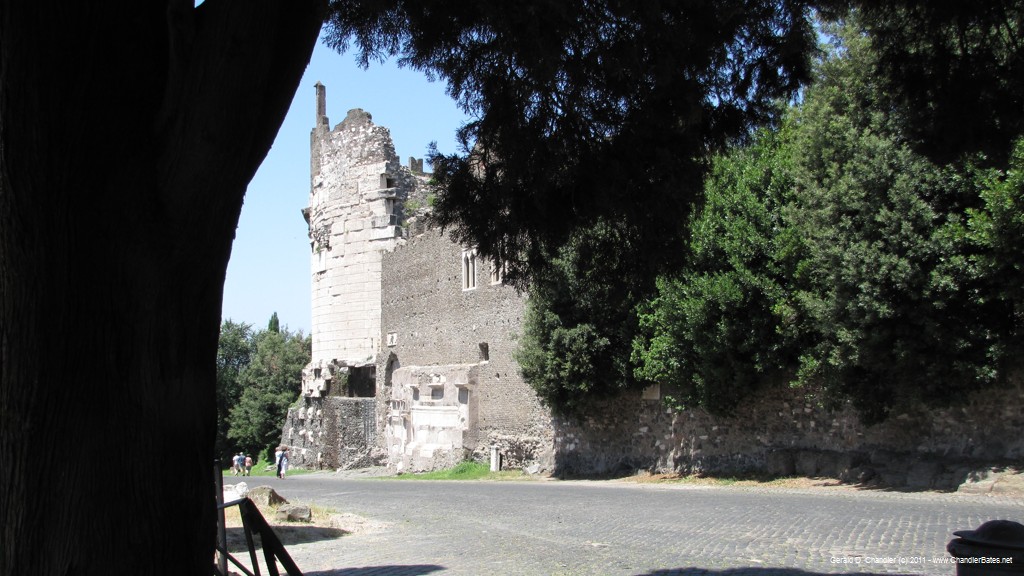
The tomb of Cecilia Metella on the Appian Way |
Rome, after all, is where the Roman republic and then Roman empire developed. So after weeks of seeing what came later — the post Christian era — we started a week of archeological tours. First, we went out west to the remains of Ostia, now called Ostia Antica. That was Rome's seaport for centuries before decline, fall, and silt lead to its death. Then we visited the great museum(s) where the collected treasures are displayed, the Museo Nationale Romano, which has such large holdings that even four monumental buildings are not enough to hold them. And then we went out to the Appian Way and walked along (some of) it, gathering a feeling of what it might have been like to have lived in Rome about 2000 years ago.
We have an apartment in the near central north of Rome, about 3 km from the main train station, Rome Termini. About another 3 km south east of the station is the start/end of the Appian way. We went out by taking our "local" bus to Termini, then taking the Metro to the Circo Massimo station, with plans to catch Bus 118 out to the Appian way. We knew from the schedule that we might have to wait as much as 35 minutes but to our delight the bus came within a minute or two of our arrival at the stop. And, happily, it wasn't crowded. We decided to go to the end of the line, a suburb called Quarto Miglio, and start our tour from there.

Runners on Appian Way going to Quarto Meglio |
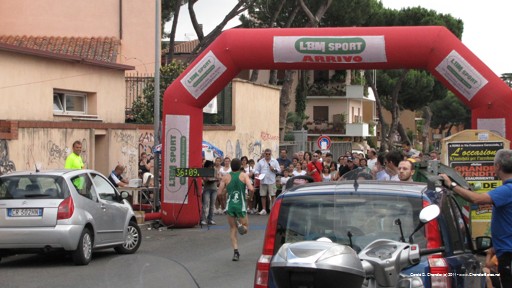
The end of the race |
As we approached Quarto Miglio we, our bus, and all other traffic were delayed: a glance out of the front window showed that some sort of road race was being run. When we arrived in QM we found that we could get off the bus just a block from the end of the race — that was instantly recognizable because the finish-line was marked by an inflatable rubber arch and it was visible from the bus. We walked over and watched runners arrive. We walked west out of town, encountering one, two, or more runners at a time, all clearly speeding up to cut a few seconds off their run time. And showing it in the face. We and they were lucky in our choice of day: it was noticably cooler than it had been for the three or four previous days.
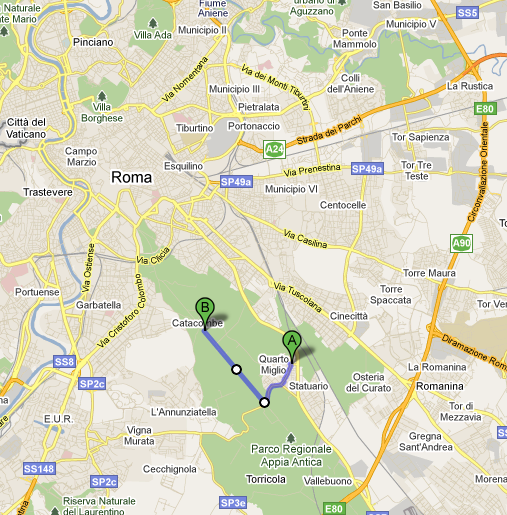
Appia Archelogical Park, SE of Rome |

Our 5 km Route |
After a kilometer or so we reached the Appian Way, in Italian the via Appia Antica because there are also two other streets that have the word Appia in them. Appia Antica of course is the real ancient Roman road. From where we were, if we turned left, we could follow it about 500 km to what had once been Magna Graecia (Great Greece, the colonies of Greece founded about 800 BC) and is and was the boot of Italy. Not so ambitious, we turned right, toward Rome and what was left of its imperial capital. (Maybe someday we'll bike the whole way!)
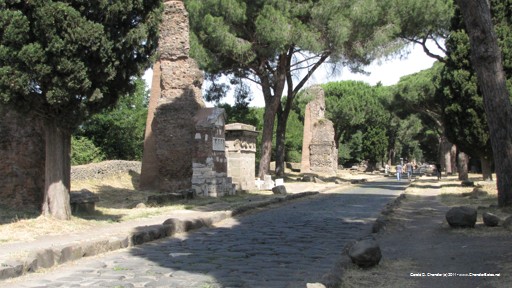
A typical stretch of the Appian Way |

Marble memorial |
The segment that we walked is part of a giant archeological park that extends from the southeast into the heart of Rome. We planned to go about 2km, as our guide book indicated this was the area with the greatest remaining treasures. Most of them consisted of well worn funeral/grave markers, with a few mounds that were much higher.
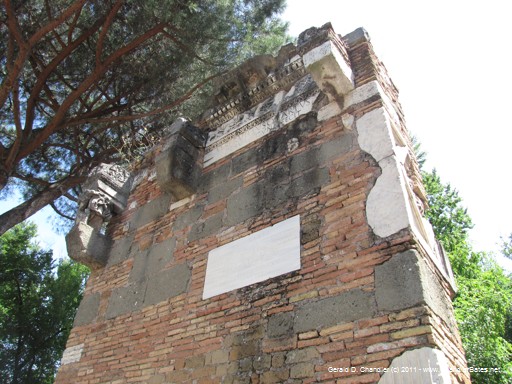
One of the taller remains |

Enjoying the Appian Way another way |
The old Roman road is a very popular destination at weekends for Roman families. Lots of people were out on bikes, jogging, walking the dog, and just enjoying the early morning freshness afforded by the abundant trees that line the road. The road itself is largely made of original volcanic slabs, still marked by the endless wagon wheels that traversed them over the centuries. They make for difficult biking, so the cyclists have worn paths on either side of the road to avoid the worst bumps.
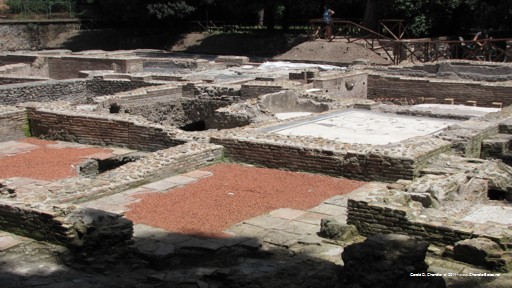
Capo di Bove Baths |
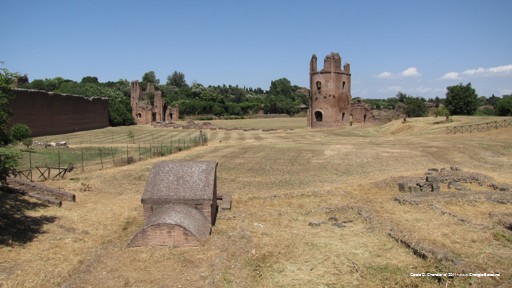
Circus of Maxentius |
The three biggest things came near our walk's end: the Capo di Bove, the remains of a private roman bath; the tomb of Cecilia Mettella, converted in the 14th century into a rather imposing castle; and the large remains of the Circo di Massenzion (Circus of Maxentius), the best preserved Circus in Rome.
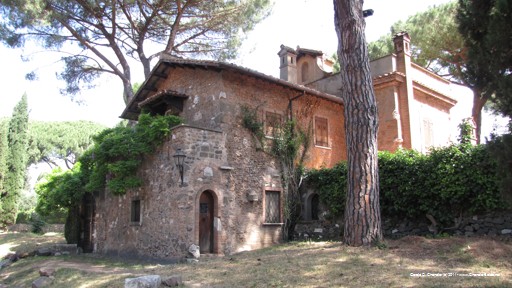
Private home along the Appian Way |

Entrance to Luxury home |
Along the way we passed gates that lead to fabulous looking estates. Some enquires revealed the situation: About two hundred years ago the Appian Way had been preserved by a Pope taking control of it and the fringes, to 20 meters out on both sides. Much of the rest in recent times has become home to the very, very rich. We're told that 10 million euros might be a starting price; that Gina Lollobrigida has a home here and that today it is a preferred spot for entertainment personalities. (In fact, the Italian equivalent to Hollywood, Cinecitta, is just a few kilometers away.)
During our walk we saw from the outside various Christian sites. There are at least three sets of catacombs but we didn't have the time or energy to go into any of them. And there are various churches, the most famous being that at the site of Domine Quo Vadis We did visit the Church of San Sebastiano. It was once one of the churches in a seven church pilgrimage. The church had a rather remarkable reclining statue of San Sebastiano complete with two arrows, done by Giuseppe Giorgetti in the late 1600s, as well as an amazing wooden painted ceiling with relief work. Its related catacombs are closed on Sunday and so we couldn't have visited if we'd wanted.
The end of the day is always an unwinding of the beginning. In this case we caught Bus 118 back to Circo Massimo. Unfortunately for us we waited nearly 30 minutes and the bus was packed. At Circo Massimo metro we decided for Bus 3 as it went pretty close to home. It was even more packed. So packed that a pick-pocket was able to bump and rebump Jan until he got her coin purse. Fortunately that held under 5 euros and nothing important, except dignity, was lost. The lesson is always the same: get on an over-crowded bus at your peril.